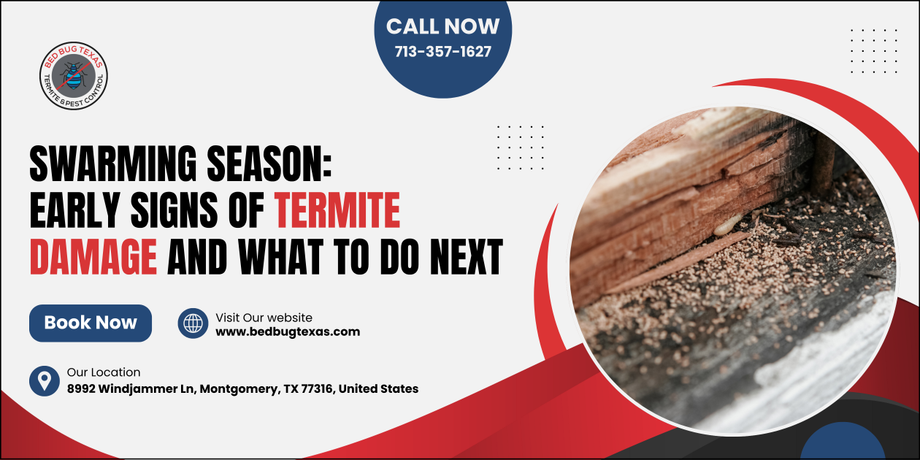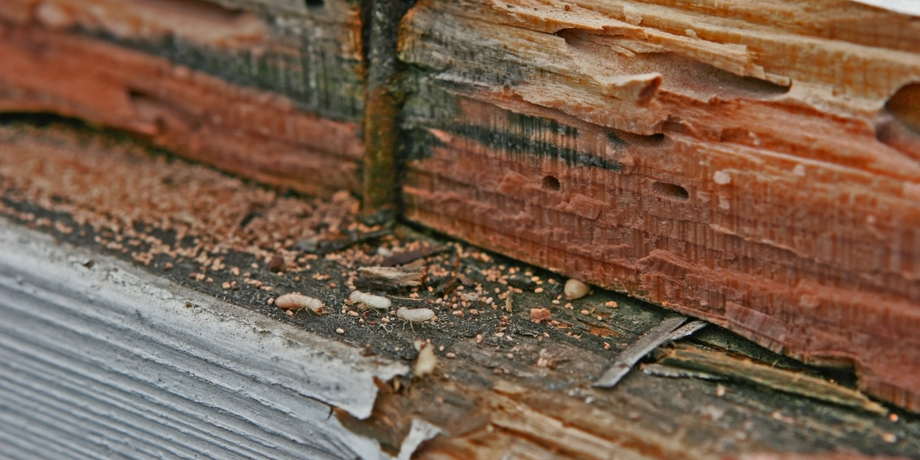Swarming Season: Early Signs of Termite Damage and What To Do Next
 Bed Bug Texas
Bed Bug Texas
Have you ever spotted a pile of tiny wings on your windowsill and thought, “Where did these even come from?” Most of us have, and we usually brush it off, assuming it’s just bugs doing their thing. But what if those wings weren’t random? What if they were the first sign that termites have already made themselves at home, inside your walls, under your floors, and are quietly chewing through your house?
Swarming season is a wake-up call. In this blog, we’ll walk you through the early signs of What Does Termite Damage Look Like, how to tell if you're dealing with flying termites, and exactly what to do next before a small issue turns into a costly nightmare.
What Exactly Is Swarming Season?
Swarming season usually kicks off in the spring and stretches into the warmer months, especially after rain.
During this time, winged termites, also known as alates, leave their existing colony to search for a new place to settle. If you're spotting them near your windows, doors, or light fixtures, it’s a huge warning sign.
Now, termites do not bite or sting, but their presence means one of these two things:
There is already an active termite colony nearby (possibly in or under your home)
Your home is at risk of becoming a nesting site for termites.
In a state like Texas, homes are especially vulnerable because of the humid climate, wooden home structures, and long warm seasons. This makes it easier for termites to survive and spread. That’s why acting early can save you from serious structural damage down the line.
5 Early Signs of What Termite Damage Looks Like
People often mistake flying termites for flying ants, but only one eats your home from the inside out. You can tell them apart by the shape of their wings. Termites usually have wings of equal length, whereas flying ants have uneven wings. Here are some early signs of termites damage you should watch out for:
Discarded Wings Around Windows and Doors
If you find paper-thin, silvery wings scattered near windowsills, it’s termite evidence. After swarming, termites with wings shed them and crawl into the nearest wood to build a new colony. If you're sweeping up piles of tiny wings, you’re likely dealing with an active infestation.
Mud Tubes on Walls or Foundations
Termites build mud tubes or little dirt tunnels to travel from the ground to your home’s wooden parts without drying out or exposing themselves.
If you find a small, muddy vein running along your foundation wall, try breaking it open using a broom. If it’s active, you’ll see live termites inside. And if it’s dry? That doesn’t mean you're safe. It just means they’ve moved on to a better spot inside.
Hollow or Blistered Wood
If any of your wooden furniture sounds hollow or papery, termites have likely tunneled through the inside. You might also notice blisters or bubbling in paint, which can look like water damage but is often caused by termites gnawing beneath the surface.
Sticking Doors and Windows
When termites eat the wood around doorframes or windows, it warps. You will find that suddenly your windows won’t close properly, and doors start sticking. You think it’s humidity, but it’s not. It’s bugs.
Clicking Sounds in the Walls
Believe it or not, termites make noise. If you hear faint clicking, tapping, or rustling in your walls, especially at night, don’t ignore it.

How to Get Rid of Termites Without Making It Worse
If you see flying termites, broken wings, or signs of damage, it’s time to act fast. If you’re thinking about how to get rid of termites, just know this isn’t something you should handle on your own. Sprays or home tricks might kill a few, but they won’t stop the whole colony. The longer you wait, the worse it gets.
Here’s what actually works:
1. Professional Termite Inspection
Before anything else, get a licensed pest control expert to inspect your home. They’ll identify:
The species (subterranean, drywood, or dampwood)
Entry points in your home
The termite colony’s location and size
The extent of the damage
This inspection tells you what the actual treatment plan should be.
2. Targeted Treatment Options
Depending on the severity and type, a trusted pest control company may recommend:
Liquid Soil Treatments: This will help create a protective barrier around your home.
Bait Stations: These are set up to attract termites, poison them slowly, and destroy the colony from within.
Foam or Dust Treatments: Treatments are injected directly into walls or wood where termites hide.
Fumigation (for drywood termites): A whole-structure gas treatment for massive infestations.
These aren’t overnight fixes, but they will help in the long term.
Follow-Up and Monitoring
The best exterminators don’t just leave you hanging after the treatment. They’ll monitor your home post-treatment, make sure termites don’t return, and often offer warranties or annual checkups. One excellent example is The Bed Bug Texas Termite & Pest Control. Despite the name, they’re not limited to bed bugs; they treat everything from termites and ants to rodents, mosquitoes, and more.
How to Protect Your Home After Treatment and Keep Termites from Coming Back
Getting rid of termites is just the first step. The real win is to make sure they never return. Here’s how to protect your home after termite treatment:
Address moisture immediately by fixing any leaky pipes, gutters, or poor drainage around your home.
Seal all cracks or gaps in your foundation.Keep firewood and mulch at least 20 feet away from your home.
Schedule annual inspections to help catch any activity early.
Invest in monitoring systems if you live in a high-risk area.
Final Words
We get it, seeing a few winged insects might not seem like a big deal. But flying termites are the loudest quiet warning your house can give you. They signal that something worse is happening behind the walls, under the floors, and inside the structure of your home.
If you spot even the smallest of the signs, take it seriously because Texas homes offer the perfect conditions for them to thrive. The good news is that you don’t have to figure it out alone. Call in the pros, get an inspection, and stop the damage before it costs you thousands.
Subscribe to my newsletter
Read articles from Bed Bug Texas directly inside your inbox. Subscribe to the newsletter, and don't miss out.
Written by

Bed Bug Texas
Bed Bug Texas
At Bed Bug Texas, we're here to help with all your pest control needs in Montgomery, TX. Our family-owned business is committed to providing effective solutions using top-notch equipment. Whether dealing with bed bugs or termites, you can count on us for quick, affordable, and dependable pest elimination.